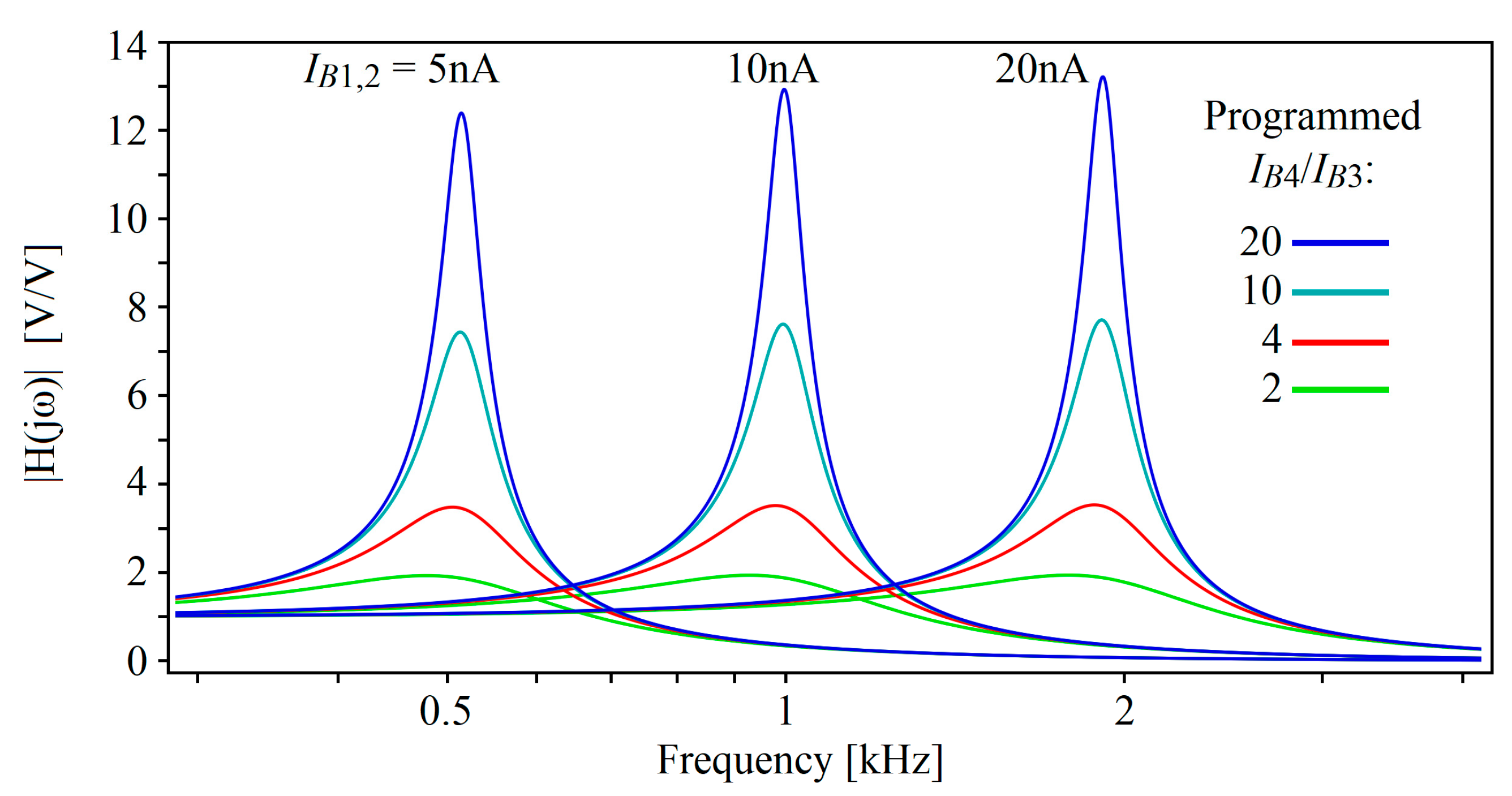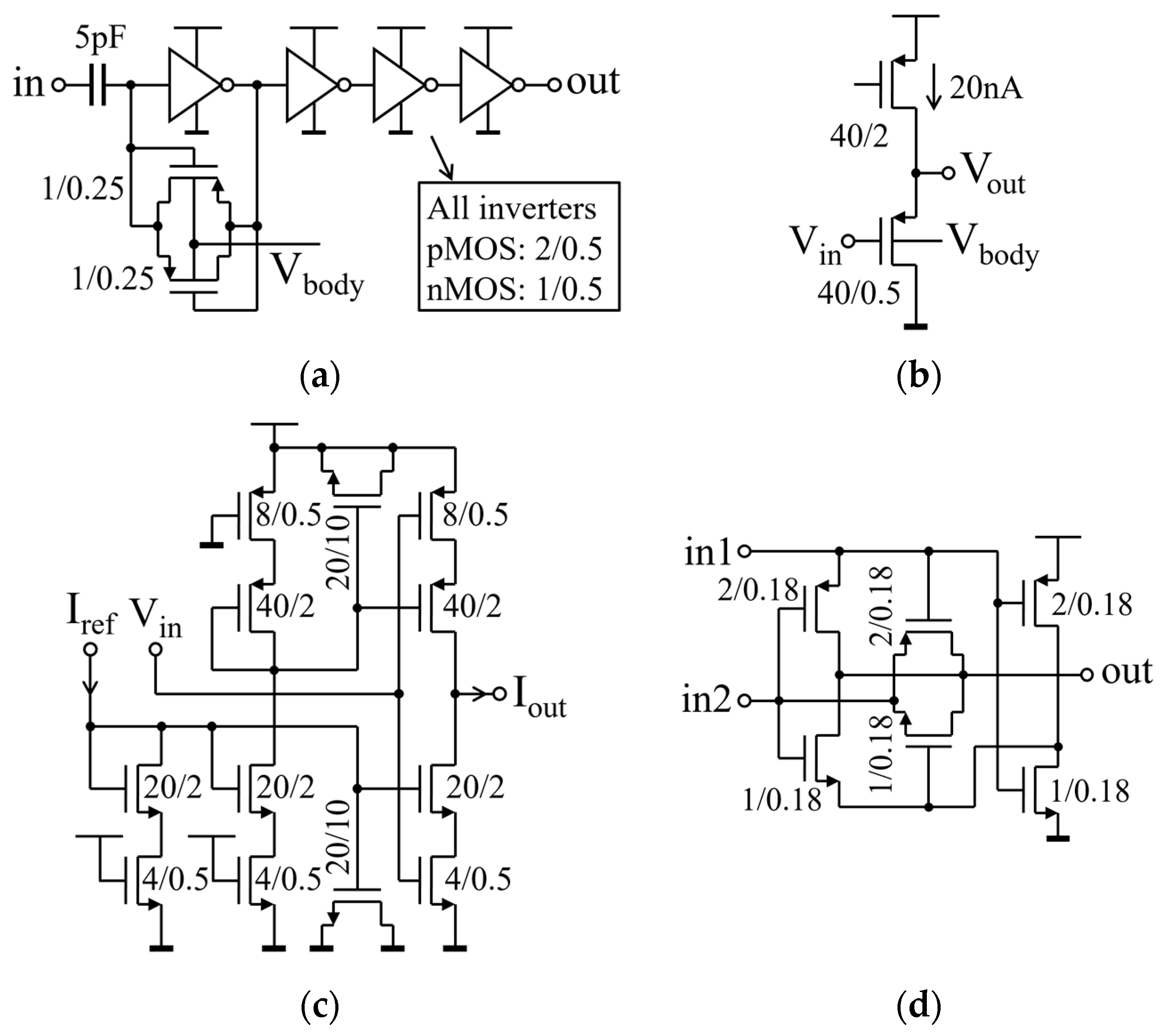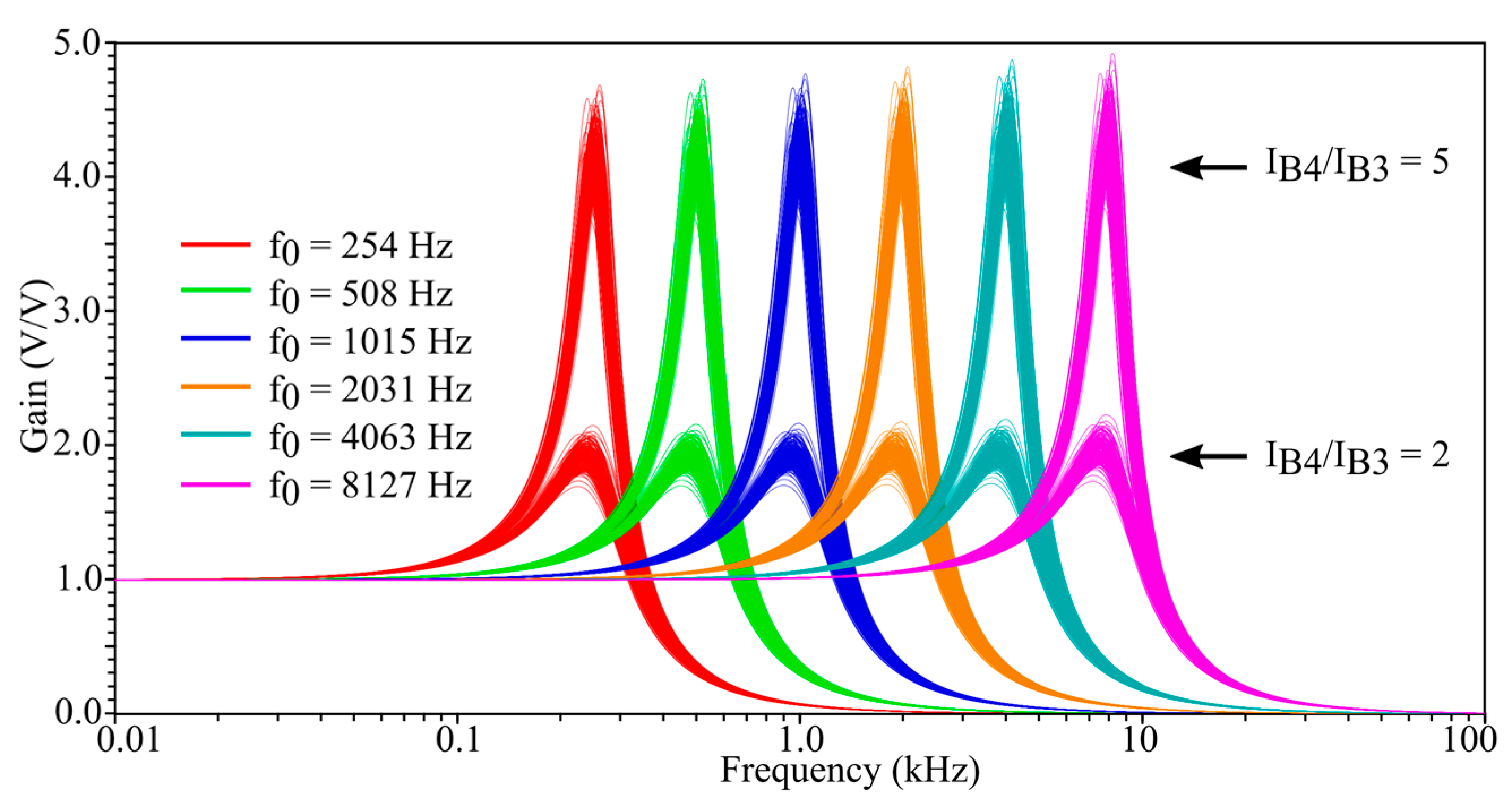Fully Tunable Analog Biquadratic Filter for Low-Power Auditory Signal Processing in CMOS Technologies
Abstract
1. Introduction
2. Filter
2.1. Effect of Reduced Resistance
2.2. Bias and Threshold Voltage Control
3. Frequency Tuning System
4. Filter Bank
5. Discussion
6. Conclusions
Author Contributions
Funding
Data Availability Statement
Conflicts of Interest
References
- Russo, M.; Stella, M.; Sikora, M.; Pekić, V. Robust Cochlear-Model-Based Speech Recognition. Computers 2019, 8, 5. [Google Scholar] [CrossRef]
- Ahn, W.; Kim, D.; Park, J.; Park, J.H.; Lee, T.; Jeong, K.; Min, K.S.; Lee, H.; Je, M. A Reconfigurable Neural Stimulation IC with a High-Resolution Strength Control and In-Situ Neural Recording Function for Cochlear Implant Systems. IEEE Solid-State Circuits Lett. 2022, 5, 162–165. [Google Scholar] [CrossRef]
- Karrenbauer, J.; Klein, S.; Schönewald, S.; Gerlach, L.; Blawat, M.; Benndorf, J.; Blume, H. SmartHeaP—A High-level Programmable, Low Power, and Mixed-Signal Hearing Aid SoC in 22 nm FD-SOI. In Proceedings of the 48th IEEE European Solid State Circuits Conference, ESSCIRC 2022, Milan, Italy, 19–22 September 2022; pp. 265–268. [Google Scholar] [CrossRef]
- Yip, M.; Jin, R.; Nakajima, H.H.; Stankovic, K.M.; Chandrakasan, A.P. A Fully-Implantable Cochlear Implant SoC with Piezoelectric Middle-Ear Sensor and Arbitrary Waveform Neural Stimulation. IEEE J. Solid-State Circuits 2015, 50, 214–229. [Google Scholar] [CrossRef] [PubMed]
- Özbek, B.; Külah, H. A 1-V Nanopower Highly Tunable Biquadratic Gm−C Bandpass Filter for Fully Implantable Cochlear Implants. In Proceedings of the 2021 IEEE Biomedical Circuits and Systems Conference, BioCAS, Berlin, Germany, 7–9 October 2021; pp. 1–5. [Google Scholar] [CrossRef]
- Özbek, B.; Külah, H. A 9.03 µW Low Noise Highly Tunable Analog Front-End for Fully Implantable Cochlear Prosthesis. In Proceedings of the 2022 IEEE Biomedical Circuits and Systems Conference, BioCAS 2022, Taipei, Taiwan, 13–15 October 2022; pp. 349–353. [Google Scholar] [CrossRef]
- Yang, M.; Chien, C.-H.; Delbruck, T.; Liu, S.-C. A 0.5 V 55 μW 64 × 2 Channel Binaural Silicon Cochlea for Event-Driven Stereo-Audio Sensing. IEEE J. Solid-State Circuits 2016, 51, 2554–2569. [Google Scholar] [CrossRef]
- Shan, W.; Yang, M.; Xu, J.; Lu, Y.; Zhang, S.; Wang, T.; Yang, J.; Shi, L.; Seok, M. A 510nW 0.41V Low-Memory Low-Computation Keyword-Spotting Chip Using Serial FFT-Based MFCC and Binarized Depthwise Separable Convolutional Neural Network in 28 nm CMOS. In Proceedings of the 2020 IEEE International Solid-State Circuits Conference, ISSCC 2022, San Francisco, CA, USA, 16–20 February 2020; pp. 230–232. [Google Scholar] [CrossRef]
- Kim, K.; Gao, C.; Graça, R.; Kiselev, I.; Yoo, H.J.; Delbruck, T.; Liu, S.C. A 23μW Solar-Powered Keyword-Spotting ASIC with Ring-Oscillator-Based Time-Domain Feature Extraction. In Proceedings of the 2022 IEEE International Solid-State Circuits Conference, ISSCC 2022, San Francisco, CA, USA, 20–26 February 2022; pp. 1–3. [Google Scholar] [CrossRef]
- Yang, M.; Yeh, C.H.; Zhou, Y.; Cerqueira, J.P.; Lazar, A.A.; Seok, M. Design of an always-on deep neural network-based 1 µW voice activity detector aided with a customized software model for analog feature extraction. IEEE J. Solid-State Circuits 2019, 54, 1764–1777. [Google Scholar] [CrossRef]
- Yang, M.; Liu, H.; Shan, W.; Zhang, J.; Kiselev, I.; Kim, S.J.; Enz, C.; Seok, M. Nanowatt acoustic inference sensing exploiting nonlinear analog feature extraction. IEEE J. Solid-State Circuits 2021, 56, 3123–3133. [Google Scholar] [CrossRef]
- Zhang, S.; Su, F.; Wang, Y.; Mai, S.; Pun, K.P.; Tang, X. A Low-Power Keyword Spotting System with High-Order Passive Switched-Capacitor Bandpass Filters for Analog-MFCC Feature Extraction. IEEE Trans. Circuits Syst. I Reg. Pap. 2023, 70, 4235–4248. [Google Scholar] [CrossRef]
- Shi, E.; Tang, X.; Pun, K.P. A 270 nW switched-capacitor acoustic feature extractor for always-on voice activity detection. IEEE Trans. Circuits Syst. I Reg. Pap. 2021, 68, 1045–1054. [Google Scholar] [CrossRef]
- Villamizar, D.A.; Muratore, D.G.; Wieser, J.B.; Murmann, B. An 800 nW switched-capacitor feature extraction filterbank for sound classification. IEEE Trans. Circuits Syst. I Reg. Pap. 2021, 68, 1578–1588. [Google Scholar] [CrossRef]
- Wei, Y.; Ma, T.; Ho, B.K.; Lian, Y. The Design of Low-Power 16-Band Nonuniform Filter Bank for Hearing Aids. IEEE Trans. Biomed. Circuits Syst. 2019, 13, 112–123. [Google Scholar] [CrossRef]
- Cosentino, S.; Falk, T.H.; McAlpine, D.; Marquardt, T. Cochlear Implant Filterbank Design and Optimization: A Simulation Study. IEEE/ACM Trans. Audio Speech Lang. Process. 2014, 22, 347–353. [Google Scholar] [CrossRef]
- Liu, S.-C.; van Schaik, A.; Minch, B.A.; Delbruck, T. Asynchronous binaural spatial audition sensor with 2 × 64 × 4 channel output. IEEE Trans. Biomed. Circuits Syst. 2014, 8, 453–464. [Google Scholar] [CrossRef] [PubMed]
- Wang, S.; Koickal, T.J.; Hamilton, A.; Cheung, R.; Smith, L.S. A bio-realistic analog CMOS cochlea filter with high tunability and ultra-steep roll-off. IEEE Trans. Biomed. Circuits Syst. 2015, 9, 297–311. [Google Scholar] [CrossRef] [PubMed]
- Badami, K.M.H.; Lauwereins, S.; Meert, W.; Verhelst, M. A 90 nm CMOS, 6 μW Power-Proportional Acoustic Sensing Frontend for Voice Activity Detection. IEEE J. Solid-State Circuits 2016, 51, 291–302. [Google Scholar] [CrossRef]
- Shah, S.; Hasler, J. Low power speech detector on a FPAA. In Proceedings of the 2017 IEEE International Symposium on Circuits and Systems, ISCAS, Baltimore, MD, USA, 28–31 May 2017; pp. 1–4. [Google Scholar] [CrossRef]
- Nägele, R.; Finkbeiner, J.; Stadtlander, V.; Grözing, M.; Berroth, M. Analog Multiply-Accumulate Cell with Multi-Bit Resolution for All-Analog AI Inference Accelerators. IEEE Trans. Circuits Syst. I Reg. Pap. 2023, 70, 3509–3521. [Google Scholar] [CrossRef]
- Jakusz, J.; Jendernalik, W. A 0.5 V Nanowatt Biquadratic Low-Pass Filter with Tunable Quality Factor for Electronic Cochlea Applications. Electronics 2024, 13, 399. [Google Scholar] [CrossRef]
- Kim, K.; Liu, S.-C. Continuous-Time Analog Filters for Audio Edge Intelligence: Review on Circuit Designs [Feature]. IEEE Circuits Syst. Mag. 2023, 23, 29–48. [Google Scholar] [CrossRef]
- Jendernalik, W.; Jakusz, J.; Blakiewicz, G. Low-Voltage Low-Power Filters with Independent ω0 and Q Tuning for Electronic Cochlea Applications. Electronics 2022, 11, 534. [Google Scholar] [CrossRef]
- Jendernalik, W.; Jakusz, J.; Blakiewicz, G. Ladder-Based Synthesis and Design of Low-Frequency Buffer-Based CMOS Filters. Electronics 2021, 10, 2931. [Google Scholar] [CrossRef]
- Razavi, B. Chapter 16: Phase-Locked Loops. In Design of Analog CMOS Integrated Circuits, 2nd ed.; McGraw-Hill Education: New York, NY, USA, 2017; ISBN 978-0-07-252493-2. [Google Scholar]
- Schaumann, R.; Tan, M.A. The Problem of On-Chip Automatic Tuning in Continuous-Time Integrated Filters. In Proceedings of the 1989 IEEE International Symposium on Circuits and Systems, ISCAS, Portland, OR, USA, 8–11 May 1989; pp. 106–109. [Google Scholar] [CrossRef]
- Glinianowicz, J.; Jakusz, J.; Szczepanski, S.; Sun, Y. High-frequency two-input CMOS OTA for continuous-time filter applications. IEE Proc. Circuits Devices Syst. 2000, 147, 13–18. [Google Scholar] [CrossRef]
- Jovanovic, G.S.; Mitic, D.B.; Stojcev, M.K.; Antic, D.S. Phase-Synchronizer based on gm-C All-Pass Filter Chain. Adv. Electr. Comput. Eng. 2012, 12, 39–44. [Google Scholar] [CrossRef]
- Moon, Y.; Choi, J.; Lee, K.; Jeong, D.-K.; Kim, M.-K. An All-Analog Multiphase Delay-Locked Loop Using a Replica Delay Line for Wide-Range Operation and Low-Jitter Performance. IEEE J. Solid-State Circuits 2000, 35, 377–384. [Google Scholar] [CrossRef]
- Jakusz, J.; Jendernalik, W.; Blakiewicz, G.; Kłosowski, M.; Szczepański, S. A 1-nS 1-V Sub-1-µW Linear CMOS OTA with Rail-to-Rail Input for Hz-Band Sensory Interfaces. Sensors 2020, 20, 3303. [Google Scholar] [CrossRef] [PubMed]
- Yan, F.; Xiong, B.; Mo, W.; Sun, K.; Guan, J.; Liu, J. A 0.816nW 12.3pS Tunable Low-Gm Transconductor for Bio-electrical Signal Acquisition. In Proceedings of the 2024 IEEE International Symposium on Circuits and Systems, ISCAS, Singapore, 19–22 May 2024; pp. 1–5. [Google Scholar] [CrossRef]







| Transistor 1 | Size [µm/µm] | IDS [nA] | gm [nS] | |VDS| [mV] | |VDSsat| [mV] |
|---|---|---|---|---|---|
| M1 | 2 × 10/2 | 5 (20 2) | 154 (425 2) | 160 (155 2) | 47 (47.5 2) |
| M2 | 2 × 10/2 | 5 (20 2) | 154 (425 2) | 172 (202 2) | 47 (47.5 2) |
| M3 | 1/2 | 5 (20 2) | 129 (342 2) | 182 (217 2) | 35 (37 2) |
| M4 | 1/2 | 5 (20 2) | 129 (342 2) | 170 (170 2) | 35 (37 2) |
| M5 | 40/0.5 | 0.25 | 8.5 | 200 | 44 |
| M6 | 10/6 | 0.25 | 8.2 | 200 | 48 |
| MB1,2 | 2 × 10/4 | 10 | 282 | 157 | 49 |
| MB3* | 20 × 1/4 | 30 | 740 | 128 | 47.5 |
| MB4 | 20 × 1/4 | 30 | 740 | 127 | 47.5 |
| ω0 (Hz) | 254 | 320 | 403 | 508 | 640 | 806 | 1015 | 1280 | 1612 | 2031 | 2560 | 3225 | 4063 | 5120 | 6450 | 8127 |
|---|---|---|---|---|---|---|---|---|---|---|---|---|---|---|---|---|
| IB1,2 | 10 nA | |||||||||||||||
| C1,2 (pF) | 94.19 | 74.56 | 59.17 | 46.97 | 37.28 | 29.58 | 23.48 | 18.64 | 14.79 | 11.74 | 9.32 | 7.39 | 5.87 | 4.66 | 3.69 | 2.93 |
| Power | 16∙40 nW at Q = 1 (IB3 = 30 nA, IB4 = 30 nA) | |||||||||||||||
| 16∙27 nW at Q = 10 (IB3 = 3 nA, IB4 = 30 nA) | ||||||||||||||||
| Parameter | 2014, [17] | 2016, [19] | 2016, [7] | 2017, [20] | 2019, [10] | 2021, [11] | 2021, [5] | 2024, [22] | This Work (Simulated) |
|---|---|---|---|---|---|---|---|---|---|
| Application | cochlea | edge | cochlea | edge | edge | edge | cochlea | cochlea | cochlea |
| Process, nm | 350 | 90 | 180 | 350 | 180 | 65 | 180 | 180 | 180 |
| Supply, V | 3.3 | 0.5 | 0.5 | 2.5 | 0.6 | 0.6 | 1.0 | 0.5 | 0.5 |
| Filter type | LPF OTA-C | BPF OTA-C | BPF SF-based | BPF OTA-C | BPF SSF-based | BPF FVF-based | BPF OTA-C | LPF Buffer-based | LPF OTA-C |
| Bank | 64 | 16 | 64 | 12 | 16 | 16 | 12 1 | 5 2 | 16 |
| Range, kHz | 0.1–20 | 0.075–5 | 0.008–20 | 0.1–5 | 0.1–5 | 0.1–5 | 0.085–6.5 | 0.5–8 | 0.3–10 |
| Q | 5-bit control | 1.3 | 1.3–39 | 2 | 2 | 2 | 1–3.7 | 2–11 | 1–14 |
| Bank power consumpt. | mW-range | 0.3 nW @75 Hz 20 nW @5 kHz | <55/2 µW | 150 µW | 61.3 nW | 14 nW | 13.2 nW @950 Hz | 2.2–52 nW @1 kHz | 640 nW @Q = 1 432 nW @Q = 10 |
| S/N, dB | 36–52 | 40–45 | 40–55 | - | 55 | - | 52 | 59 | 62 |
Disclaimer/Publisher’s Note: The statements, opinions and data contained in all publications are solely those of the individual author(s) and contributor(s) and not of MDPI and/or the editor(s). MDPI and/or the editor(s) disclaim responsibility for any injury to people or property resulting from any ideas, methods, instructions or products referred to in the content. |
© 2024 by the authors. Licensee MDPI, Basel, Switzerland. This article is an open access article distributed under the terms and conditions of the Creative Commons Attribution (CC BY) license (https://creativecommons.org/licenses/by/4.0/).
Share and Cite
Jendernalik, W.; Jakusz, J. Fully Tunable Analog Biquadratic Filter for Low-Power Auditory Signal Processing in CMOS Technologies. Electronics 2024, 13, 3132. https://doi.org/10.3390/electronics13163132
Jendernalik W, Jakusz J. Fully Tunable Analog Biquadratic Filter for Low-Power Auditory Signal Processing in CMOS Technologies. Electronics. 2024; 13(16):3132. https://doi.org/10.3390/electronics13163132
Chicago/Turabian StyleJendernalik, Waldemar, and Jacek Jakusz. 2024. "Fully Tunable Analog Biquadratic Filter for Low-Power Auditory Signal Processing in CMOS Technologies" Electronics 13, no. 16: 3132. https://doi.org/10.3390/electronics13163132
APA StyleJendernalik, W., & Jakusz, J. (2024). Fully Tunable Analog Biquadratic Filter for Low-Power Auditory Signal Processing in CMOS Technologies. Electronics, 13(16), 3132. https://doi.org/10.3390/electronics13163132







